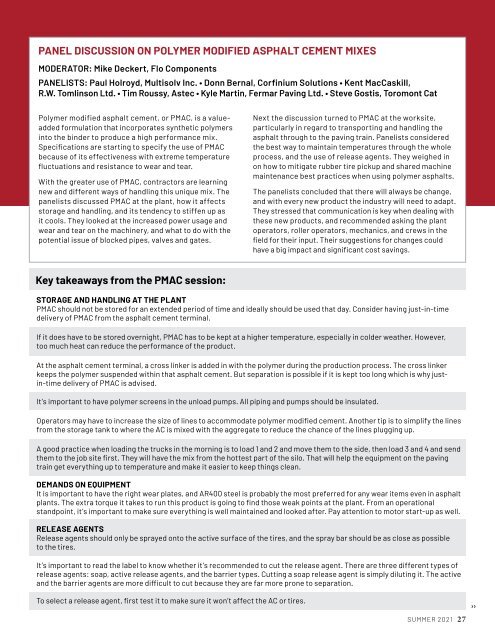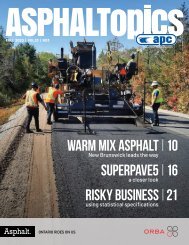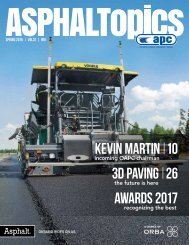ASPHALTopics | Summer 2021 | VOL 34 | NO 2
Create successful ePaper yourself
Turn your PDF publications into a flip-book with our unique Google optimized e-Paper software.
PANEL DISCUSSION ON POLYMER MODIFIED ASPHALT CEMENT MIXES<br />
MODERATOR: Mike Deckert, Flo Components<br />
PANELISTS: Paul Holroyd, Multisolv Inc. • Donn Bernal, Corfinium Solutions • Kent MacCaskill,<br />
R.W. Tomlinson Ltd. • Tim Roussy, Astec • Kyle Martin, Fermar Paving Ltd. • Steve Gostis, Toromont Cat<br />
Polymer modified asphalt cement, or PMAC, is a valueadded<br />
formulation that incorporates synthetic polymers<br />
into the binder to produce a high performance mix.<br />
Specifications are starting to specify the use of PMAC<br />
because of its effectiveness with extreme temperature<br />
fluctuations and resistance to wear and tear.<br />
With the greater use of PMAC, contractors are learning<br />
new and different ways of handling this unique mix. The<br />
panelists discussed PMAC at the plant, how it affects<br />
storage and handling, and its tendency to stiffen up as<br />
it cools. They looked at the increased power usage and<br />
wear and tear on the machinery, and what to do with the<br />
potential issue of blocked pipes, valves and gates.<br />
Next the discussion turned to PMAC at the worksite,<br />
particularly in regard to transporting and handling the<br />
asphalt through to the paving train. Panelists considered<br />
the best way to maintain temperatures through the whole<br />
process, and the use of release agents. They weighed in<br />
on how to mitigate rubber tire pickup and shared machine<br />
maintenance best practices when using polymer asphalts.<br />
The panelists concluded that there will always be change,<br />
and with every new product the industry will need to adapt.<br />
They stressed that communication is key when dealing with<br />
these new products, and recommended asking the plant<br />
operators, roller operators, mechanics, and crews in the<br />
field for their input. Their suggestions for changes could<br />
have a big impact and significant cost savings.<br />
Key takeaways from the PMAC session:<br />
STORAGE AND HANDLING AT THE PLANT<br />
PMAC should not be stored for an extended period of time and ideally should be used that day. Consider having just-in-time<br />
delivery of PMAC from the asphalt cement terminal.<br />
If it does have to be stored overnight, PMAC has to be kept at a higher temperature, especially in colder weather. However,<br />
too much heat can reduce the performance of the product.<br />
At the asphalt cement terminal, a cross linker is added in with the polymer during the production process. The cross linker<br />
keeps the polymer suspended within that asphalt cement. But separation is possible if it is kept too long which is why justin-time<br />
delivery of PMAC is advised.<br />
It’s important to have polymer screens in the unload pumps. All piping and pumps should be insulated.<br />
Operators may have to increase the size of lines to accommodate polymer modified cement. Another tip is to simplify the lines<br />
from the storage tank to where the AC is mixed with the aggregate to reduce the chance of the lines plugging up.<br />
A good practice when loading the trucks in the morning is to load 1 and 2 and move them to the side, then load 3 and 4 and send<br />
them to the job site first. They will have the mix from the hottest part of the silo. That will help the equipment on the paving<br />
train get everything up to temperature and make it easier to keep things clean.<br />
DEMANDS ON EQUIPMENT<br />
It is important to have the right wear plates, and AR400 steel is probably the most preferred for any wear items even in asphalt<br />
plants. The extra torque it takes to run this product is going to find those weak points at the plant. From an operational<br />
standpoint, it’s important to make sure everything is well maintained and looked after. Pay attention to motor start-up as well.<br />
RELEASE AGENTS<br />
Release agents should only be sprayed onto the active surface of the tires, and the spray bar should be as close as possible<br />
to the tires.<br />
It’s important to read the label to know whether it’s recommended to cut the release agent. There are three different types of<br />
release agents: soap, active release agents, and the barrier types. Cutting a soap release agent is simply diluting it. The active<br />
and the barrier agents are more difficult to cut because they are far more prone to separation.<br />
To select a release agent, first test it to make sure it won’t affect the AC or tires.<br />
SUMMER <strong>2021</strong> 27<br />
››

















